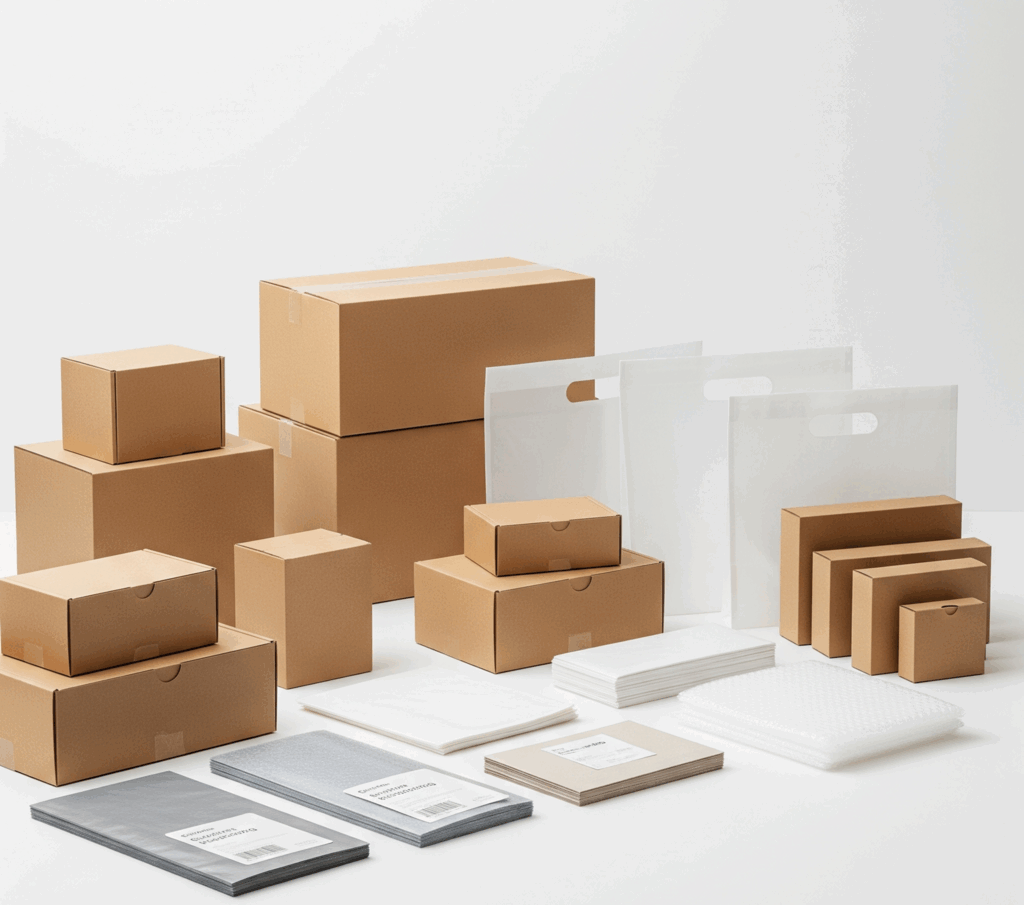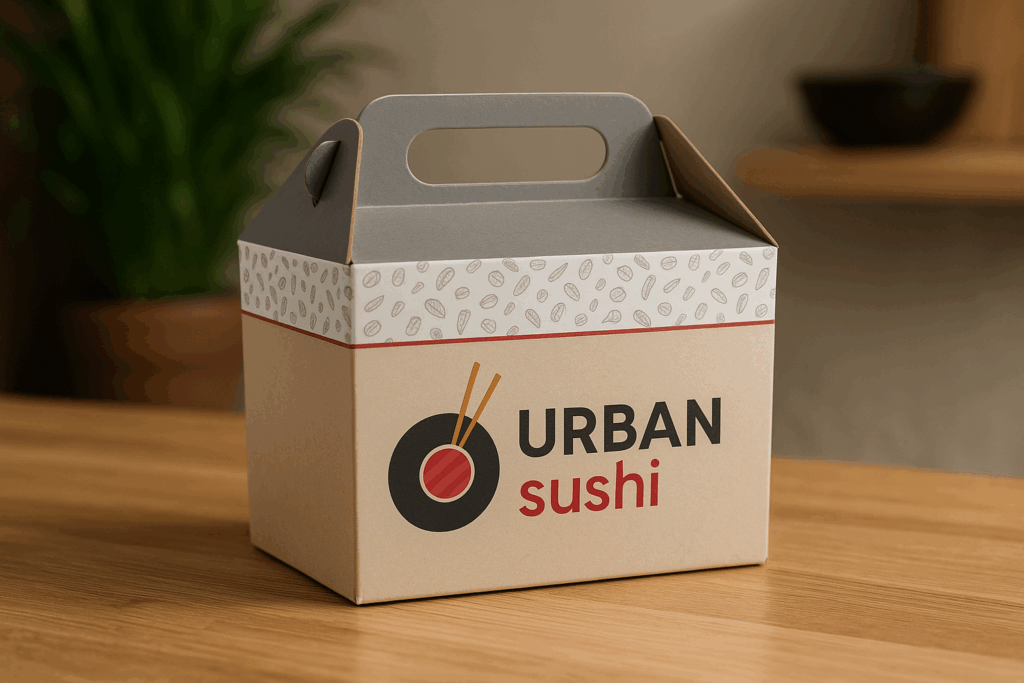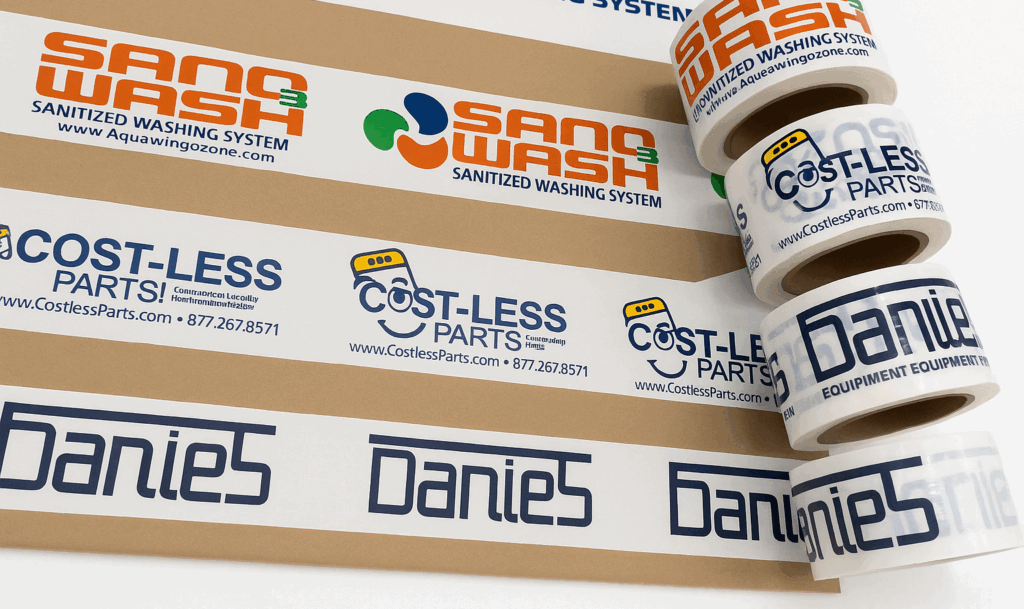Choosing between stock and custom packaging isn’t always straightforward. Stock packaging is ready-made and available in standard sizes, while custom packaging is designed specifically for your brand with your colors, logo, and exact specifications. This guide breaks down the key differences to help you figure out which option makes the most sense for your business right now.
We’ll look at costs, timing, branding impact, and other practical factors that affect your decision. No fluff, just the information you need to make a smart choice.
What is Stock Packaging?

Stock packaging is the ready-to-ship, off-the-shelf option available in standard sizes and materials. Think plain white poly mailers, brown corrugated boxes, or basic bubble mailers that you can order and use right away.
These generic options work well for businesses that are just starting out, companies that ship a wide variety of products, or those focused more on function than presentation. Many B2B companies and service-based businesses use stock packaging because their customers care more about receiving items quickly and safely than about the unboxing experience.
Stock packaging has some clear advantages: it’s cheaper upfront, available immediately, and doesn’t require any design work. You can order small quantities as needed, which helps with cash flow. The main downside? It doesn’t help your brand stand out or create a memorable impression.
What is Custom Packaging?

Custom packaging is designed specifically for your brand and products. This includes anything from poly mailers printed with your logo and colors to boxes made in custom dimensions with full-color printing inside and out.
Custom packaging is popular with premium e-commerce brands, subscription box companies, cosmetics and beauty products, and businesses where the unboxing experience matters. If you’ve ever received a package that made you want to take a photo before opening it, that was probably custom packaging at work.
The biggest benefits of custom packaging are brand recognition, customer experience, and the perfect fit for your products. Custom sizes can even save on shipping costs by reducing package dimensions. The main drawbacks are higher upfront costs, longer lead times, and usually larger minimum orders.
Stock vs. Custom: Side-by-Side Comparison
| Feature | Stock Packaging | Custom Packaging |
| Upfront Cost | Low (no setup fees) | Higher (design and setup fees) |
| Per-Unit Cost | Higher at low volumes | Lower at high volumes |
| Lead Time | Immediate/1-3 days | 2-6 weeks typically |
| Minimum Order | As low as 1 unit | Usually 250-1,000+ units |
| Branding | Generic, no branding | Fully branded experience |
| Storage Needs | Can order as needed | Requires space for bulk orders |
| Customer Experience | Basic, functional | Premium, memorable |
| Scalability | Easy to switch as needed | Better economies at scale |
| Product Protection | Standard sizes may need filler | Sized perfectly for your products |
Cost Considerations
Stock Packaging Costs
Stock packaging won’t break the bank when you’re starting out. You can order exactly what you need—even just 10 or 25 units—without any setup fees or design costs. This makes it perfect for testing the waters or handling seasonal rushes.
The catch? You’ll pay more per unit, especially if you’re shipping a lot of packages. Those $1-2 poly mailers add up when you’re sending hundreds of orders each month.
Custom Packaging Costs
Custom packaging requires an upfront investment. You’ll pay for design work, printing plates or digital setup, and samples before your first full order. Depending on the complexity, this might run anywhere from $200 to $1,000+ before you get your first box or mailer.
The good news is that your per-unit cost drops significantly at higher volumes. A custom-printed poly mailer might cost less than a stock one once you’re ordering 1,000+ at a time. Custom-sized boxes can also save on shipping by reducing dimensional weight.
The Real Cost Calculation
When comparing costs, look beyond just the price of the packaging itself:
- Will custom sizes reduce your shipping costs?
- How much are you spending on inserts, tissue paper, or stickers to make stock packaging feel more branded?
- What’s the value of a customer sharing your packaging on social media?
- Will better packaging reduce returns due to damaged products?
Time to Launch & Lead Times
If you need packaging tomorrow, stock is your only option. Most suppliers can ship stock packaging within 1-3 business days, and some offer next-day delivery. This makes stock packaging perfect for unexpected rushes or when you’re just starting out and can’t wait weeks for packaging.
Custom packaging follows a different timeline:
- Design phase: 1-2 weeks
- Sample production and approval: 1-2 weeks
- Production: 2-4 weeks
- Shipping: 3-10 days (depending on location)
All in, you’re looking at 4-8 weeks from concept to delivery for most custom packaging. Plan accordingly if you’re launching a new product or preparing for a busy season.
Branding and Customer Experience
This is where custom packaging really shines. Your packaging is often the first physical interaction a customer has with your brand. It’s a chance to make that connection tangible.
Custom packaging helps:
- Reinforce your brand identity
- Create a memorable unboxing experience
- Encourage social sharing and word-of-mouth
- Make customers feel they’ve purchased something special
For some businesses, like subscription boxes or premium beauty products, the unboxing experience is almost as important as the product itself. Customers expect something Instagram-worthy.
Stock packaging can still look professional, but it won’t create that same emotional connection. For purely functional products or B2B shipments, this might not matter much.
Product Fit & Protection
One often overlooked aspect of packaging is how well it protects your products. Stock packaging comes in standard sizes, which means you’ll often need to use void fill (bubble wrap, air pillows, paper) to prevent items from moving around. This adds cost, time, and waste.
Custom packaging can be designed to fit your products exactly, with inserts or compartments that hold items securely. This not only looks more professional but also provides better protection during shipping.
If you sell fragile items or products with unique dimensions, custom packaging might actually save you money by reducing damage rates and returns.
Business Stage & Use Case Matching
Different business stages and models call for different packaging approaches:
Stock packaging works best for:
- New businesses testing the market
- Companies with wide product variety and dimensions
- Seasonal businesses with fluctuating needs
- B2B shipments where function trumps presentation
- Businesses with unpredictable order volumes
Custom packaging makes sense for:
- Established brands with consistent order volumes
- Premium or luxury products
- Subscription services
- Products with unusual dimensions
- Businesses where customer experience is a key differentiator
- Companies shipping 500+ packages monthly
Sustainability and Environmental Impact
Both stock and custom packaging can be eco-friendly, depending on the materials you choose.
Stock packaging often uses standard materials that are widely recyclable, like corrugated cardboard or kraft paper. The downside? Standard sizes might be larger than necessary for your products, leading to wasted materials and higher shipping emissions.
Custom packaging allows you to right-size your packaging, using only the materials needed. You can also choose sustainable options like compostable mailers or recycled content. However, custom packaging sometimes involves more specialized materials that might be harder to recycle.
For the most sustainable approach:
- Choose right-sized packaging (custom or stock)
- Select recyclable or compostable materials
- Minimize excess packaging and void fill
- Consider the full lifecycle, including shipping weight
Inventory Management & Storage Space
Stock packaging is easy to manage—order what you need, when you need it. This frees up cash flow and storage space, especially important for small businesses with limited warehouse room.
Custom packaging typically requires larger orders to be cost-effective, meaning you’ll need space to store it. You’ll also need to forecast your needs months in advance to avoid running out.
Consider these questions:
- How much storage space do you have?
- Can you predict your packaging needs 2-3 months ahead?
- Do you have the cash flow to order in bulk?
- Will your branding or product sizes change soon?
Flexibility & Scaling
As your business grows and changes, your packaging needs will too.
Stock packaging offers flexibility—you can easily switch sizes or styles as needed. This works well for businesses with changing product lines or seasonal variations.
Custom packaging provides better economies of scale. The more you order, the less you pay per unit. This makes it ideal for established businesses with predictable needs. However, it’s less flexible if your products or branding change.
Many businesses start with stock packaging and gradually transition to custom as they grow and stabilize their product offerings.
Tips for Choosing the Right Option
Ask yourself these questions to help decide:
- What’s your monthly shipping volume?
- How important is brand presentation to your customers?
- Do you have the budget for upfront design and setup costs?
- How quickly do you need packaging?
- Are your products and branding likely to change soon?
- What are your competitors doing with their packaging?
Don’t just follow trends—make a decision based on your specific business needs and customer expectations.
Hybrid Options: Best of Both Worlds?

Can’t decide? Consider these hybrid approaches that blend stock and custom elements:
- Use stock boxes or mailers with custom-printed tape
- Add branded stickers or labels to stock packaging
- Use custom tissue paper, thank you cards, or inserts inside stock packaging
- Try custom-printed sleeves that slide over standard boxes
These options give you some branding benefits without the full cost and commitment of custom packaging. They’re perfect for businesses that want to stand out but aren’t ready for fully custom solutions.
For example, a plain poly mailer with a colorful custom sticker can create a branded look for a fraction of the cost of fully printed mailers.
How to Get Started
Ready to make a decision? Here’s how to move forward:
- Assess your current needs: shipping volume, product sizes, budget, and timeline
- Request samples of both stock and custom options to compare quality
- Calculate the total cost, including shipping and storage
- Consider starting small with hybrid options if you’re unsure
The Bottom Line
There’s no one-size-fits-all answer to the stock vs. custom packaging question. The right choice depends on your specific business needs, budget, timeline, and customers.
Stock packaging offers speed, flexibility, and lower upfront costs. Custom packaging creates a stronger brand impression and can actually save money at higher volumes.
Many successful businesses start with stock packaging and add custom elements as they grow. Others jump straight to custom to make a strong brand statement from day one.
Whatever stage your business is at, Plus Packaging can help you find packaging that fits your needs and budget. Browse our selection of stock options or talk to our team about custom solutions that won’t break the bank.